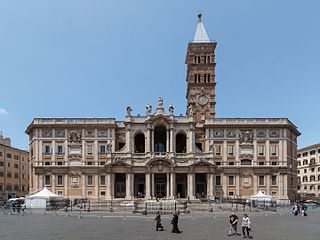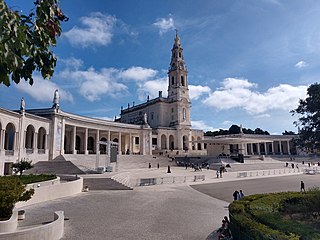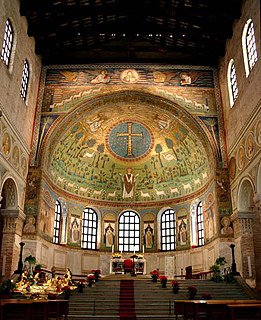
A shrine to the Virgin Mary is a shrine marking an apparition or other miracle ascribed to the Blessed Virgin Mary, or a site on which is centered a historically strong Marian devotion. Such locales are often the destination of pilgrimages.

Fátima is a city in the municipality of Ourém, in the Central Region and Médio Tejo intermunicipal community of Portugal, with 71.29 km2 of area and 11,788 inhabitants (2011). Its population density is 162.7 inhabitants/km2. The homonymous civil parish encompasses several villages and localities of which the city of Fátima, with a population of 7,756 residents, is the largest.

Panaji is the capital of the Indian state of Goa and the headquarters of North Goa district. It lies on the banks of the Mandovi River estuary in the Tiswadi sub-district (taluka). With a population of 114,759 in the metropolitan area, Panaji is Goa's largest urban agglomeration, ahead of Margao and Vasco da Gama.

Braga is a city and a municipality in the northwestern Portuguese district of Braga, in the historical and cultural Minho Province. The city has a resident population of 192,494 inhabitants, representing the seventh largest municipality in Portugal. Its area is 183.40 km2. Its agglomerated urban area extends from the Cávado River to the Este River. It is the third-largest urban centre in Portugal.

In architecture, an apse is a semicircular recess covered with a hemispherical vault or semi-dome, also known as an exedra. In Byzantine, Romanesque, and Gothic Christian church architecture, the term is applied to a semi-circular or polygonal termination of the main building at the liturgical east end, regardless of the shape of the roof, which may be flat, sloping, domed, or hemispherical. Smaller apses are found elsewhere, especially in shrines.

The Basilica of the National Shrine of the Immaculate Conception is a large Catholic minor basilica and national shrine located in Washington, D.C., United States, on 400 Michigan Ave NE, Washington, DC 20017, adjacent to the Catholic University of America.

Théodore Guérin, designated by the Vatican as Saint Theodora, and born Anne-Thérèse Guérin, was a French-American saint and the foundress of the Sisters of Providence of Saint Mary-of-the-Woods, a congregation of Catholic sisters at Saint Mary-of-the-Woods, Indiana. Pope John Paul II beatified Guérin on 25 October 1998, and Pope Benedict XVI canonized her a Saint of the Roman Catholic Church on 15 October 2006. Guérin's feast day is 3 October, although some calendars list it in the Roman Martyrology as 14 May, her day of death.
The Dominican House of Studies, located in Washington, DC, houses both the Priory of the Immaculate Conception, a community of the Province of St. Joseph of the Order of Preachers (Dominicans), and Pontifical Faculty of the Immaculate Conception, an Ecclesiastical Faculty of theology. It is dedicated to the theological formation of Dominican friars and the service of the church in the Archdiocese of Washington. It serves as a formation community for Dominican candidates for Holy Orders and the Dominican cooperator brotherhood. It is also the location of the Thomistic Institute and the academic journal The Thomist.

Pauline of the Agonizing Heart of Jesus, C.I.I.C., was an immigrant from Austria-Hungary to Brazil, who became the foundress of the Congregation of the Little Sisters of the Immaculate Conception, religious sisters who serve the poor. She became the first female Brazilian to be proclaimed a saint by the Catholic Church, when she was canonized on 19 May 2002 by Pope John Paul II. Pauline suffered from diabetes for much of her life and is considered by some to be a patron saint of diabetics.

Beatrice of Silva, O.I.C., also known as Beatriz da Silva y de Menezes and as Beatriz de Menezes da Silva, was a noblewoman of Portugal, who became the foundress of the monastic Order of the Immaculate Conception of Our Lady in Spain. She is honored as a saint by the Roman Catholic Church.

The Shrine of Our Lady of Lebanon is a Marian shrine and a pilgrimage site in Lebanon.

Roman Marian churches are religious buildings dedicated to the veneration of the Blessed Virgin Mary. These churches were built throughout the history of the Catholic Church, and today they can be found on every continent including Antarctica. The history of Marian church architecture tells the unfolding story of the development of Roman Catholic Mariology.

The Sanctuary of Fátima, also known as Sanctuary of Our Lady of Fátima, is a group of Catholic religious buildings and structures in Cova da Iria, in the civil parish of Fátima, in the municipality of Ourém, in Portugal.

The Church of the Immaculate Conception on the motherhouse grounds of the Sisters of Providence of Saint Mary-of-the-Woods is a large Italian Renaissance Revival-style church constructed of Indiana limestone at Saint Mary-of-the-Woods, Indiana. The cathedral-like structure, which is the fourth church/chapel of the Sisters of Providence since their arrival at Saint Mary-of-the-Woods in 1840. Construction for the church began in 1886; its exterior was completed in 1891 and the interior was completed in 1907. The church was consecrated on October 23, 1907, and continues to serve as a place of daily worship services that are open to the public. The church also houses the shrine and tomb of Saint Mother Théodore Guérin, foundress of the Sisters of Providence of Saint Mary-of-the-Woods. Our Lady of Sorrows Chapel (1905) was erected in the crypt beneath the church.

The Metropolitan co-cathedral of Saint Mary Major of Mérida is a Roman Catholic cathedral church in Mérida, Extremadura, western Spain. Since 1994, together with the Metropolitan Cathedral of Saint John the Baptist of Badajoz, it is the seat of the Archdiocese of Mérida-Badajoz.

The Monastery of the Immaculate Conception is a monastery in Ferdinand, Indiana. It is home to one of the largest communities of Benedictine women in the United States. It is located approximately fifteen minutes from St. Meinrad Archabbey.

The Hermitage of Greccio Sanctuary is one of the four shrines erected by St. Francis in the Sacred Valley, along with the Sanctuary of Fonte Colombo, the Sanctuary of the Forest, and the convent of Poggio Bustone. It is located in the Italian town of Greccio, about 15 kilometres (9.3 mi) from the city of Rieti, seat of the homonym province, is recessed at an altitude of 665 metres (2,182 ft) above sea level, in the rocks of the mountains in the immediate vicinity of the medieval village of Greccio with stunning views of the wide Rieti Valley.

The Parish Church of the Immaculate Conception of Our Lady is a Roman Catholic parish church in Ħamrun, Malta. It was built between 1958 and 1963 and it took over the role of an oratory dedicated to the Immaculate Conception which had been established in Ħamrun in 1923. It has been a parish church since 1968.


















